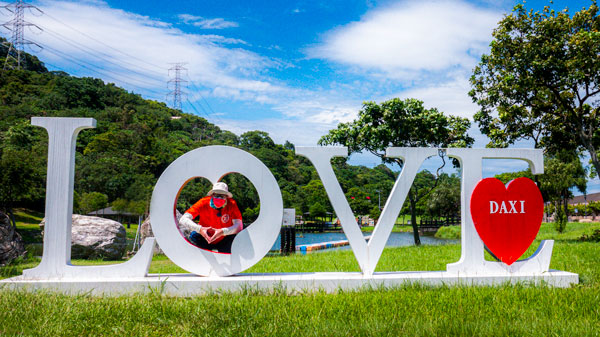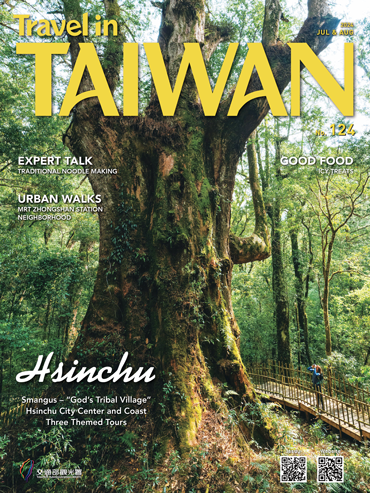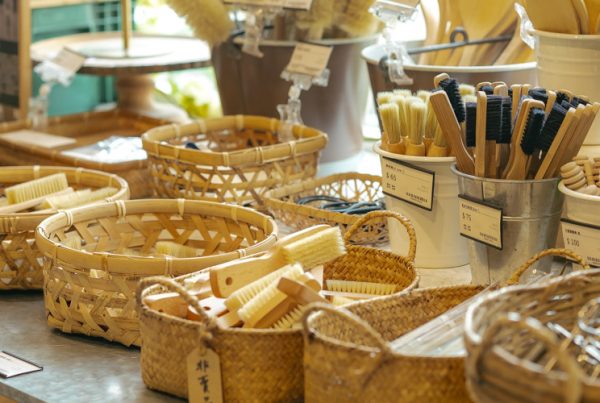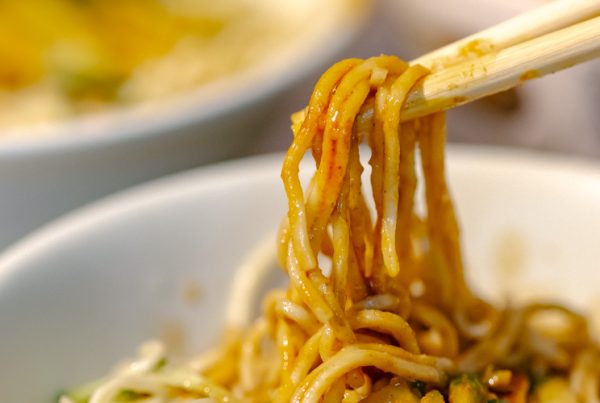A Bike Ride Connecting the Towns of Yingge and Daxi
TEXT / TWELLI
PHOTOS / TWELLI, VISION
The town of Yingge in New Taipei City is well known as Taiwan’s most important center for ceramics production. The town of Daxi in Taoyuan City is well known for its Old Street area and dried tofu. Both settlements sit on the same river, the Dahan, and are connected by riverside bikeways and minor roads that make it possible to visit them on a one-day bike outing.
Taipei City and New Taipei City both have excellent riverside bikeway systems, which are interconnected. All major rivers in the Taipei Basin – the Tamsui, Keelung, Xindian, Dahan, Shuangxi, and Jingmei – are lined with riverside parks and well-paved bike paths on both banks that allow residents and visitors alike to enjoy carefree bicycling, away from busy streets with motorized vehicles. An outing on the riverside bikeways of Taipei can easily be expanded by going further southwest. The Dahan merges with the Xindian at the southwestern corner of Taipei City to form the Tamsui, which flows north to meet the sea. It is possible to ride from the Dahan-Xindian confluence all the way upriver to the town of Yingge (about 18km) and then even further southwest. In this article, however, we start our ride in Yingge. To get there from Taipei you can hop on a local train, which takes less than 30 minutes.
Note: It’s possible to take your own bicycle onto a local train; please find related information on the Taiwan Railways Administration website. If you want to rent a public bicycle, there are several docking stations of the YouBike system both in Yingge and Daxi.
Starting in Yingge
There are two must-visit tourist attractions in Yingge, the Old Street area and the New Taipei City Yingge Ceramics Museum. In the Old Street area you’ll find a cluster of shops selling pottery items that make great souvenirs, such as teapots and ceramic cups. The modern-design museum has displays of fine pieces of ceramics art. You can easily spend half a day exploring Yingge town, but since we’ll be focusing on riverside bicycling today, let’s move straight to the west (or left) bank of the Dahan River.
From Yingge Railway Station, it’s just a 15min walk or a short ride (if you’ve brought your own bike) to the Sanying Art Village. After exiting the station (rear entrance), turn right and follow Wenhua Road; before reaching the ceramics museum take Lane 371; upon reaching Guanqian Road you will see the “village,” which is a park with ceramics-themed art installations perfect for taking selfies.

The centerpiece is a 15m-tall reddish-brown leaning tower that looks a bit like what you’d expect to see on the potter’s wheel of someone who tries pottery for the first time.

If you haven’t brought your own bike, there is a YouBike docking station in the park, right beside the Yingge Civil Sports Center.
Tip: At the time of writing two major construction projects were being carried out close to and inside the park. The elevated Sanying light-rail metro line is currently being built, with one of Yingge’s stations to be located between the railway station and the park. The line will connect the Taipei Metro’s Bannan Line with the towns of Sanxia and Yingge, and is expected to be completed in 2023. The second project is the construction of the New Taipei Museum of Arts, in the northern section of the park, also slated for completion in 2023.
Before starting your journey southwest along the Dahan you’ll first have to cross the tunnel-like, 85m-long Sanying Longyao Bridge, which spans the small Yingge River. This stylish structure was designed to resemble a “dragon kiln” (longyao), a large elongated kiln traditionally used in commercial pottery making. The Snake Kiln in central Nantou County’s Shuili Township is an excellent example of this type of kiln.


After leaving the bridge behind, for a short stretch you’ll be following Huanhe Road before turning left and entering Nanjing Ceramics Riverside Park. This is one of the most pleasant sections of the route down to Daxi, with many lush trees providing shade.

On the left-hand side you’ll soon spot a bright-red multiple-arch water pipe bridge and behind, on the opposite side of the river, tree-covered Mt. Yuan (300m high). This is a popular destination for short hikes through thick forest, with easy access from Sanxia town. There are several vantage points on the mountain from where you have impressive 270-degree views of the river below with Yingge seen on the opposite bank and Sanxia on the near side to the right.

After reaching the southern end of the ceramics park you’ll pass under a National Freeway 3 bridge and then will soon come close to a large dam spanning the river, the Yuanshan Weir. Built in 1983 and operated by the Taiwan Water Corporation, this weir is used to catch water released by the Shimen Reservoir, about 19km upstream, for diversion to the Banxin Water Treatment Plant. After processing there the water is then piped to the households of about two million people living in Taoyuan City and New Taipei City.

Blocked by the weir, the river is much wider to the south. In the evening the lake-like body of water here becomes especially enchanting as the sun sets. The stretch of riverside bikeway west of the weir is thus also known as the Yingge Central River Sunset Trail.

Further on, the bikeway remains flat and well-paved. There are pavilions and lookout platforms along the way where you can stop for a rest and enjoy the pleasant river and mountain scenery, with a good chance of spotting waterbirds in the wetland areas by the river.
Down in Daxi
After entering Taoyuan City’s Daxi District, you’ll be riding through large open spaces (make sure to protect yourself against strong sunshine, and also prepare yourself for the possibility of strong headwinds). There are several different paths you can take here; just make sure to follow the river. There is a strong rural countryside feel, with rice paddies and vegetable fields along the way. If you come in September, there’s the chance of seeing fields of blooming garlic chives, the white blossoms making the fields appear as if covered under a layer of snow.

Next up is another large manmade body of water, the Zhongzhuang Retention Basin. Built in 2013, this basin is used for storing clean water needed as backup in case the water inside the Shimen Reservoir becomes too turbid during/after typhoons because of heavy rainfall. Shooting out over the water at the basin’s southern end is a small glass-bottom lookout platform (only open weekends/holidays), which has become a popular photo-taking spot.


After passing through a riverside area lush with shrubs and bushes, you’ll arrive at the Daxi Riverside Park. Separated from the river by a massive dike, this is a fun place for children, complete with playground areas and a baseball field. There is also a square pond featuring two unusually tall floating goals facing each other, and you might wonder about their purpose. The answer: The pond is a playing field for canoe polo, a rare sight in Taiwan.

Tip: There is a YouBike docking station right outside the park, making this a perfect location for taking a break. Return your bike here at the station, relax in the park, and rent a new bike to continue your ride.
Next you’ll come to a Provincial Highway 3 bridge that spans the river. While you could ride across this bridge to reach central Daxi town, you’ll certainly prefer to go on for another few hundred meters or so and take the much prettier pedestrian Daxi Bridge instead. Build in 1934, this is a beautiful suspension bridge adorned with Baroque-style elements. It’s especially attractive in the evening when carefully positioned lights present it in all its glory.


At the far end of the bridge, you can either take the steep stairs uphill (not recommended, especially if hauling a YouBike; they are heavy!) or take the elevator (most certainly recommended), which will deliver you right inside old Zhongzheng Park. During the 1895~1945 Japanese colonial era, this park (established in 1912) was the site of Daxi’s Shinto Shrine. While the shrine is long gone (the Chaoran Pavilion today stands on the site), you can still find numerous stones with inscriptions from the colonial days inside the park and, added more recently, Japanese-style stone lanterns and even an outdoor Sumo dohyō (wrestling ring).

Tip: If you want to explore the town of Daxi on foot, there is a YouBike docking station just outside the park.
If you have an interest in history, just to the south of the park is one of the many residences used by late R.O.C. president Chiang Kai-shek during his time in Taiwan. The residence’s two main buildings are now part of an interesting museum project in Daxi called the Daxi Wood Art Ecomuseum. Informative exhibitions about wood art can be visited in a number of heritage buildings in different locations around town, including the former CKS residence buildings, now named Wooden Life Hall and Wood Furniture Hall, and the beautiful Daxi Martial Arts Dojo close by.


The town’s main attraction is its Old Street area, at the heart of which is Heping Road, a narrow street lined with old shophouses sporting beautiful façades. Look up and you will see a mix of Western-inspired Baroque-style and traditional southern Fujianese architectural elements, such as intricate carvings of birds and bats, along with the occasional shop name in English.




After having worked up an appetite on your way from Yingge, this is the place where you’ll want to replenish those lost calories. There are numerous shops and eateries to choose from. The town’s specialty is dried tofu, especially the “black dried beancurd” variety. Have a dried-tofu lunch and remember to buy a bag or two for the road or for friends and family back home.

North of Daxi
After spending some time in this lovely historic town, let’s head back north, now on the east (or right) bank of the Dahan. Rent a new YouBike, if needed, and get back down to the riverfront, then follow the bike path north, first passing through the tiny Daqing Tunnel. There is a nice pedestrian boardwalk close to the river here, but you have to take some steps down to get to it and then push your bike along, since the path is rather narrow. Hop back onto your bike after passing the aforementioned highway bridge.
Just to the north of the bridge you come to the Yuemei Recreational Farm Area. If it’s the right time of the year (Taoyuan Flower Festival in November), you’ll be presented with colorful “seas of flowers” in the fields surrounding the Hakka-style Lee Teng-fang Old Residence, which is also part of the Daxi Wood Art Ecomuseum project mentioned earlier.

Further north you can make a stop at the Shanzhuhu Hydro-Ecology Park. This new park, established by the Taoyuan City Government, has six natural ponds with a plethora of insects and plants. Go for a walk and enjoy being surrounded by the sights and sounds of nature. Beloved by photo takers are the bald cypress trees surrounding one of the ponds, especially beautiful when the trees turn orange-brown during the winter months.

Unfortunately, the riverside route ends here and does not go further north. If you feel you have done enough riding for the day, return your YouBike at the Yuemei Parking Lot docking station and then walk to the Guanyin Temple bus stop (at the gas station on Prov. Hwy 3, close to the highway bridge). From there, you can take a bus back to Yingge (No. 5101) or to the Taipei Metro’s Yongning Station (710). You can, of course, also retrace your route and ride all the way back to Yingge. If it’s late in the afternoon during a sunny day, you might even catch one of those glorious sunsets seen from near the Yuanshan Weir.
Looking for a Challenge?
While there is no bike path north of the eco-park area, there is a way to ride all the way up to the town of Sanxia (across the Dahan from Yingge), albeit a more challenging one and one that requires more gears than a YouBike can offer. So if you consider yourself a more seasoned cyclist with a lot of stamina and a properly geared bike, you can do the following.
From the eco-park area, first ride south and take the small road that connects to Prov. Hwy 3. Follow the highway east for 1.5km, then turn left onto Lane 789 of Xinyi Road. Next you will be facing a challenging, steep 2.5km uphill stretch. Shortly after passing the highest point of the road you’ll be rewarded with breathtaking views of the Dahan River from the Niangzikeng Observation Platform, especially gorgeous in the late evening when the sun is about to set.
From there it’s then downhill all the way until you are back close to the river. You’ll pass a few trailheads for hikes up Mt. Yuan, and you can take another good look at the Yuanshan Weir, now from the east bank. Immediately after passing under the aforementioned freeway bridge, turn right to be on your direct way to central Sanxia, where you can visit the picturesque Old Street and the impressive Zushi Temple. From Sanxia back to Yingge it’s another 3km, taking the highway bridge across the Dahan.







